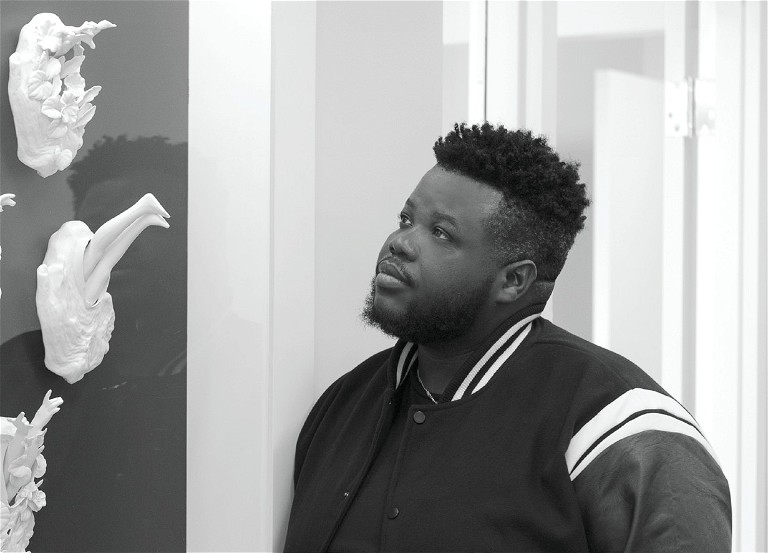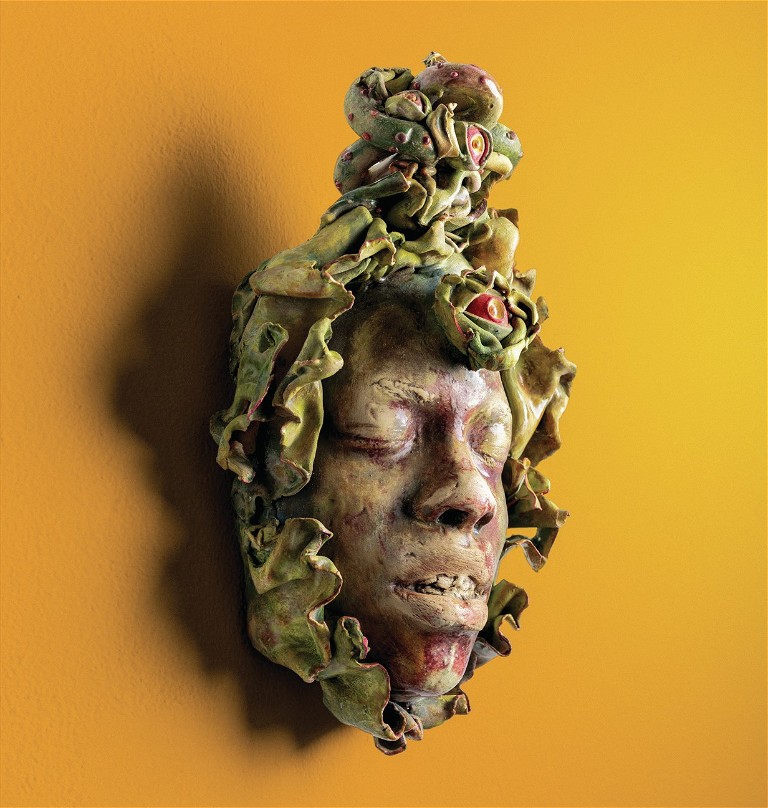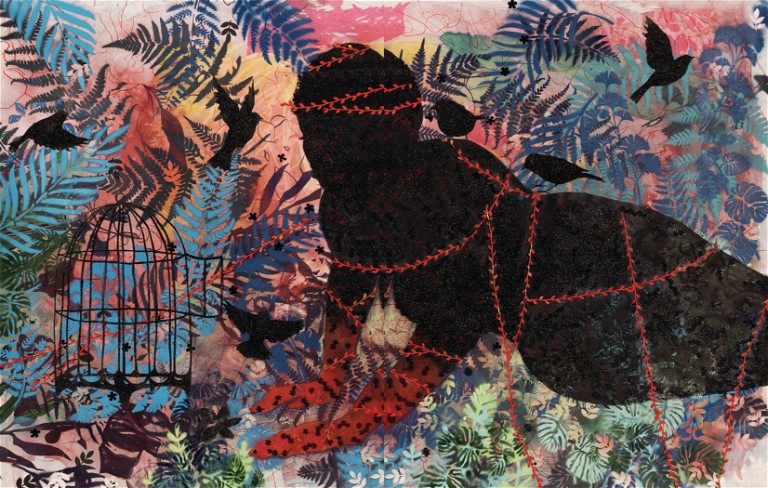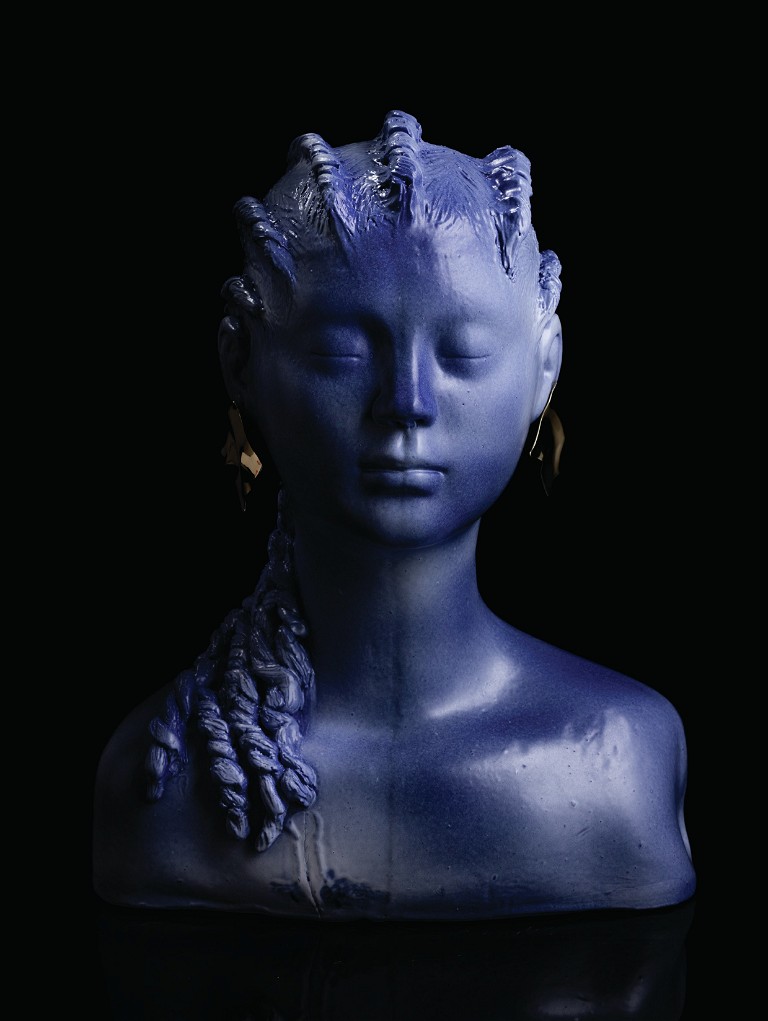CONTEMPORARY ART IN CONTEXT
Self-Mythology
MOREL DOUCET MULTIDISCIPLINARY ARTIST AND ARTS EDUCATOR

Multidisciplinary artist and educator Morel Doucet.
Morel Doucet is a Miami-based, Haitian-American multidisciplinary artist and arts educator who explores climate change, gentrification, and displacement among communities of the African diaspora through sculpture, printmaking, and illustration. He views his art as a celebration of nature within the Afrofuturism movement. Afrofuturist art incorporates futuristic and science-fiction themes with elements of Black and African culture.
Grounded in Nature
Doucet’s art is a record of his journey as a Haitian immigrant, often using the human figure as a metaphor. He considers his work to be narratives of a “self-mythology.” This mythology references climate change and sea-level rise in his home of Miami, Florida; environmental destruction; and the displacement between descendants of the African diaspora and their original physical environments. Doucetʼs works, whether they are created in porcelain, earthenware, or paint, start with a grounding in the beauty of nature, highlighting the flora, fauna, and people of Miami’s Little Haiti neighborhood. He depicts gentrification as a threat to both the environment and the people who live there.
Doucet has mastered a wide range of media in his work. His references to birds, flowers, fauna, coral reefs, and even human physiology all represent the close relationship between humans and nature, which he believes must be protected. Many of his works embody the African tradition of sculpted heads and figures that contain spiritual power, particularly in his series of ceramic busts of young Black women. These sculptures reference and celebrate the matriarchs of Haiti and West Africa. Sarah with the Good Hair and the white busts from the Oneiric series have a serene and iconic quality, particularly when adorned with birds or flowers. In Ivy from the Rève series, Doucet emphasizes his ongoing theme of dreams (either fulfilled or sacrificed) that connect humans to the environment. Black Maiden, one of his silhouettes of people from Little Haiti, pays tribute to Maya Angelouʼs 1983 poetry collection Shaker, Why Don’t You Sing? It also explores the modern plight of Black women, the red vine representing the obstacles that Black women must overcome in the United States, Haiti, and around the world.

Morel Doucet, Ivy, 2009. Ceramics and glass.
Art History: Clay
The roots of today’s fine art ceramics are found in the Arts and Crafts Movement of the late 1800s. In the mid-1900s, many sculptors used clay to produce artworks that were not only beautiful, but also referenced issues of their time. Robert Arneson’s (1930–1992) sculptures presented his concern about the nuclear arms race. Sculptor, art educator, and Harlem Renaissance artist Augusta Savage (1892–1962) urged artists of African and Hispanic descent to address issues facing their communities through clay. She inspires contemporary ceramic artists such as Aisha Harrison (b. 1989), Robert Lugo (b. 1981), and Arlene Burke-Morgan (b. 1950).

Morel Doucet, Black Maiden (The Caged Bird Sings a Soliloquy of Midnight Veil), 2022. Acrylic, ink, glitter, spray paint, paper, oil pastel, and fabric on paper, 51 x 79" (129.5 x 201 cm). Courtesy of the artist and Galerie Myrtis.
About the Artist
Morel Doucet was born in 1990 in Pilate, Haiti, and lived on a farm with his grandfather, where he began to explore humanity’s relationship to the environment. Following 1991’s coup d’état, his family obtained asylum in the United States and relocated to Miami. Doucet earned a BFA in ceramics from the Maryland Institute College of Art in 2013 after graduating from Miami’s New World School of Arts High School in 2009. He exhibits his work nationally and internationally and was one of eight African American artists featured in the 2022 Venice Biennale exhibition, The Afro-Futurist Manifesto: Blackness Reimagined. Doucet also works as a museum educator in the Miami area.
ARTIST Q&A
What are some of the biggest influences on your work?
MD: Nature has been a constant source of inspiration for me, with its intricate beauty and dynamic elements reflected in my creations. Additionally, my artistic narrative has been enriched by the multitude of traditions and practices that I have encountered across the globe, creating a rich roadmap of global influences.
Contemporary artists such as Basil Kincaid, Khari Turner, Stephen Arboite, Sheena Rose, and Naudline Cluvie Pierre captivate me with their unique styles. They challenge conventional norms and push the boundaries of artistic expression. Their innovative approaches to storytelling and unique visual languages resonate with me, inspiring me to push the envelope in my work continually.
What aspects of African art, if any, inspire your command of pattern and texture?
MD: The San People, also known as Bushmen or Basarwa, have a rich artistic heritage. They create intricate patterns and textures in their rock art and beadwork. Their art often depicts detailed representations of daily life, wildlife, and shamanistic experiences. In my latest collection, Daughter of the Copper Sun, I draw inspiration from the San People of Africa and the Ife sculptural bronze from Nigeria. I am intrigued by their ability to capture the human form with lifelike precision and intricate surface embellishments. These patterns and traditions are an essential part of the tapestry in my porcelain ceramic creations.
The African diaspora and the climate change crisis are both examples of contemporary humanity’s neglect of life-ordeath issues. How do your works make those issues clear?
MD: My sculptures combine elements of nature, human anatomy, and cultural symbols to tell visual stories that capture the interconnectedness of humanity and the natural world. The art often juxtaposes fragility and strength.
The vulnerability of coral reefs is a central theme in some of my artwork, reflecting the precarious state of these ecosystems in the face of climate change. Through my pieces, I aim to convey the significance of preserving and protecting our environment. It is clear that neglecting this issue can have severe consequences.
As a Haitian-American artist, I draw inspiration from my personal background and heritage to create artworks that delve into the themes of migration, identity, and cultural connections. Through my art, I aim to shed light on the historical and ongoing struggles encountered by people of African descent, underscoring the fact that these issues cannot be ignored or disregarded.

Morel Doucet, Sarah with the Good Hair (Black donʼt crack, and brown donʼt frown), 2022. Slip-casted white earthenware, 12 x 8½ x 15½" (30.5 x 21.5 x 39 cm). Courtesy of the artist and Galerie Myrtis.
What advice do you have for young people of color who are interested in pursuing a career in visual art?
MD: (1) Recognize that your unique perspective as a person of color brings a fresh and valuable voice to the art world. Therefore, dedicate enough time to hone your craft. Continuously work on improving your technical skills, whether it involves drawing, painting, sculpting, or any other medium. (2) Your art portfolio showcases your unique style and artistic journey. Regularly update it with your best pieces. (3) Attend art exhibitions, gallery openings, and art-related events to meet fellow artists and art enthusiasts. Building a net work of like-minded individuals can open doors to opportunities and collaborations. (4) Prioritize self-care, seek support when needed, and remember that your mental well-being is vital to your artistic journey. (5) Use your art and your voice to advocate for diversity and representation in the art world. Challenge the status quo and contribute to the ongoing conversation about inclusivity and equity in the arts.
DISCUSSION
Inform students that Doucet is a Miami-based artist originally from Haiti, and that his artwork is inspired by his Haitian and African ancestors and connections to nature. In a group discussion, analyze several of his pieces with particular attention to what your students believe may be references to nature, history, and culture. Next, ask students to discover how they might explore their own heritage or culture through artwork.
STUDIO EXPERIENCES
- Create a 2D or 3D artwork inspired by your connection(s) to plants, animals, or the natural world.
- What kinds of patterns interest you? Choose a few patterns and experiment with them on a clay tile or slab. Create several planning sketches for a ceramic vessel or form that incorporates one or more of these patterns. After revising, create a patterned ceramic piece inspired by your sketches.
- Create an artwork in any media inspired by your cultural heritage. If you’re not sure where to begin, have a discussion with an older relative about your family’s heritage— are there traditions, food, or holidays that are especially important to your family? If not, consider what elements of contemporary culture inspire you and your family.
RESOURCE
Artist Website: moreldoucet.com
External Links Disclaimer: The content in SchoolArts magazine represents the views of individual authors and artists, selected for publication by the editorial team. The resources provided are to support the teaching of art in a variety of contexts, and therefore, links to external sources are included. As such, any linked content is not monitored by SchoolArts and should be previewed by a professional before sharing with students.
Written by Karl Cole, Art Historian and Curator of Images at Davis Publications, and Robb Sandagata, Digital Curriculum Director and Editor at Davis Publications. kcole@davisart.com, rsandagata@davisart.com
Preview Mode - Subscribe to unlock full content


SchoolArts Magazine
Inspiring Creativity Since 1901
A national art education magazine committed to promoting excellence, advocacy, and professional support for educators in the visual arts.
Categories
Explore our inspiring content by topic